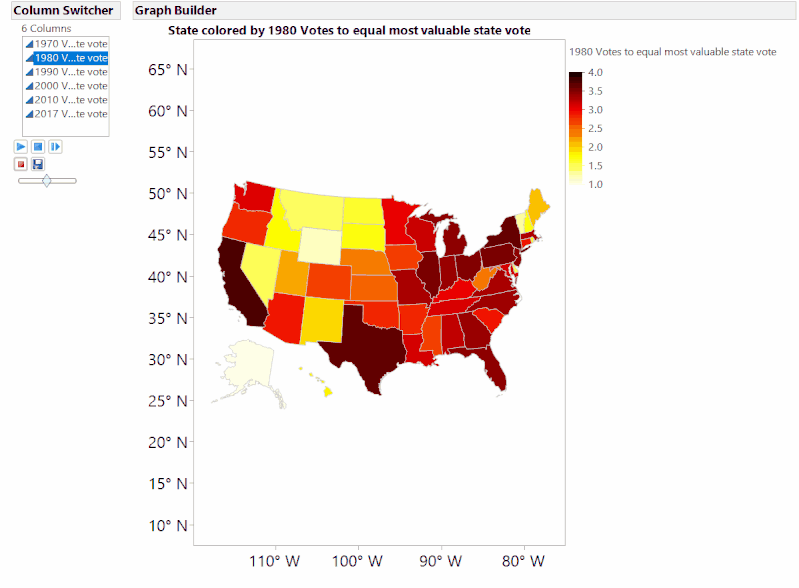Did you know that one vote for president in Wyoming is worth almost four votes for president in Texas?
How is that possible? Why would the residents of any state agree to have their votes count less than another?
I became interested in this topic a couple weeks ago when I was visiting my parents. My parents were very excited to discuss the election process. The conversation went a little like this:
Mom – “The US should switch to the popular vote to elect the president.”
Me – “Why do you think that?”
Mom (standing on a soapbox) – “Every vote should count, and we don’t want to disenfranchise voters by discounting their votes. Why would a conservative vote for president in California? Why would a liberal vote for president in Texas? Why should some people have more say than others when it comes to who is president?”
Dad – “Is dinner ready?”
I admit this is something I had not given much thought since my middle school social studies class. We continued the conversation during dinner:
Me – “How much difference can the value of a vote be?”
Mom – “I don’t know the exact numbers, but some states get twice the electors per vote than others.”
Me – “That seems broken. Can we do anything to fix it, so all votes count?”
Mom – “Yes, the National Popular Vote are a group of states that have agreed to cast all of their electors for the candidate that wins the popular vote. Right now, the states add up to 172 electoral votes, and they need another 98 votes to override the electoral college.”
Dad – “I need some wine. Anyone else need wine?”
My dad’s passion was awe-inspiring, so I had to dig into the data. Not that I didn’t believe my mom, but in the words of the famous statistician Dr. W. Edwards Deming, “In God we trust; all others bring data.” I knew the United States uses a system called the Electoral College to elect the president. I discovered that the Electoral College was established in the US Constitution as a compromise between a pure popular vote and a legislative selection. The Electoral College grants one elector per member the Congressional delegation. Each state has two Senators and a varying number of Representatives based on population. This means that every state, even those with very low population, will have at least three electors. I pulled the population and congressional delegation information from Wikipedia. Below is a map of the number of people per congressional seat (elector).

In 2017, the state with the fewest people per Congressional seat is Wyoming, where there are 193,105 people per Congressional seat. The state with the most people per Congressional seat is Texas, where there are 744,858 people per Congressional seat. That means one vote in Wyoming is worth approximately 3.86 votes in Texas when it comes to the presidential election. This conjures up thoughts of the book Animal Farm by George Orwell, who wrote: “All animals are equal, but some animals are more equal than others.” Below is a distribution of the population per Congressional seat for each state.

As you can see, the average population per congressional seat when you break it up by state (including the District of Columbia) is about 510,725 people. This is an example of a skewed distribution where most states have more people per congressional seats. The states with fewer people per Congressional seat have a lot fewer. Nineteen states and the District of Columbia have fewer people per congressional seat than the average. I applied a filter to the map to highlight those states.

If your state is highlighted in this graph, you live in a state where your presidential vote is worth more than it would be in an average state. If your state is not highlighted, your vote is not as valuable in a presidential election. The people in the non-highlighted states would be more equally represented if the popular vote were used to determine the president.
I guessed this difference in vote value must be a new thing or at least be getting worse over time due to the trend of urban migration. I pulled population and congressional representation data from Wikipedia dating back to 1970 to check it out. What I found surprised me: The discrepancy in vote value was much worse in 1970 than now, and since 1980 the trend has been flat, not getting worse on average. I made a table of summary statistics below. I also made a map of the trend and utilized the Column Switcher in JMP to show how the map changes over time.


At the state level, maximum votes to equal the most valuable vote is higher than it has been since the 1970s. This means Texans should be particularly motivated to dispense of the Electoral College. On the other hand, if you live in Wyoming or Vermont, you have a more valuable vote than every other state. Seems unfair, but this begs the question: How much does the Electoral College really affect elections?
If the US used the national popular vote in place of the Electoral College, how many past elections would have had different results? I found that five presidents were elected despite losing the popular vote: John Quincy Adams, Rutherford B. Hayes, Benjamin Harrison, George W. Bush and Donald Trump. The 1824 election saw John Quincy Adams elected over Andrew Jackson even though Jackson received more than10% more of the popular vote. After that election, irritated supporters of Jackson created the Democratic party (Jackson ran as a Democratic-Republican in 1824). Ironically, every candidate since 1824 whom has lost a presidential election despite winning the popular vote has been a Democrat.
The United States was founded by the Declaration of Independence, which states, “All men are created equal.” Should all people have equal say in who becomes the next president? Is it time to the give the Electoral College the boot?